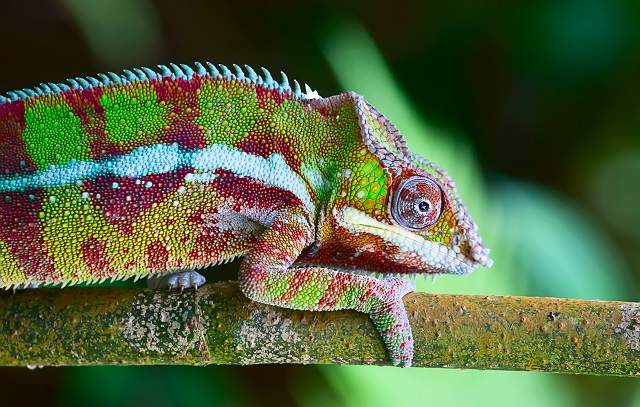
A Chameleon photographed in Thailand.
Image credit: apichart sripa / Shutterstock.com
A research team from the University of Geneva (UNIGE), Switzerland, has discovered the mechanisms that control and regulate the rapid and complex color changes in chameleons.
Many chameleons display this phenomenon during social interactions. The research has been published in Nature Communications.
The study, headed by professors Dirk van der Marel and Michel Milinkovitch, shows that these changes occur through the active modification of a nanocrystal lattice that exists in the external layer of dermal cells known as iridophores. In addition, the researchers also discovered a deeper population of iridophores that contain less ordered and larger crystals, which reflect infrared light.
In other words, the iridophores are arranged into two superimposed layers and this assembly enables the chameleons to quickly change between spectacular display and efficient camouflage and at the same time provides passive thermal protection.
Real Chameleon Color change
Chameleon changing colour - Video sourced from: YouTube
The researchers at UNIGE combined their expertise in evolutionary biology and quantum physics to explore the transition of one vivid color to another in the panther chameleon. Depending on their behaviour, male chameleons can change their colorful adornments.
Although the cellular mechanisms responsible for the transition towards a darker skin are well known, mechanisms that control and regulate the change from a dynamic hue to a bright color still remain mysterious. The Panther chameleon is one such species that can rapidly undergo this change to face a competing male or court a female chameleon.
Chameleons and other reptiles exhibit the so-called structural colors, besides red, brown and yellow pigments. The nanocrystals are organized in layers that swap with cytoplasm, within the iridophores. The resulting structure enables a selective reflection of specific wavelengths, which ultimately contributes to the bright colors of reptiles.
"These colors are generated without pigments via optical interference. They result from interactions between certain wavelengths and nanoscopic structures, such as tiny crystals present in the skin of the reptiles. These cells, which contain larger and less ordered crystals, reflect a substantial proportion of the infrared wavelengths," Michel Milinkovitch, professor at the Department of Genetics and Evolutionat UNIGE explained.
We discovered that the animal changes its colors via the active tuning of a lattice of nanocrystals. When the chameleon is calm, the latter are organised into a dense network and reflect the blue wavelengths.
In contrast, when excited, it loosens its lattice of nanocrystals, which allows the reflection of other colors, such as yellows or reds.
Suzanne Saenko and Jérémie Teyssier, co-authors
This represents a unique example of an intracellular optical system that is automatically organized and controlled by chameleons. The researchers also revealed the existence of another deeper layer of iridophores. This provides protection against the thermal effects of radiation from the sun in low-latitude regions.
The researchers intend to explore the mechanisms that describe the development of an organized nanocrystals lattice inside the iridophores, and also the cellular and molecular mechanisms that enable chameleons to control the lattice geometry.